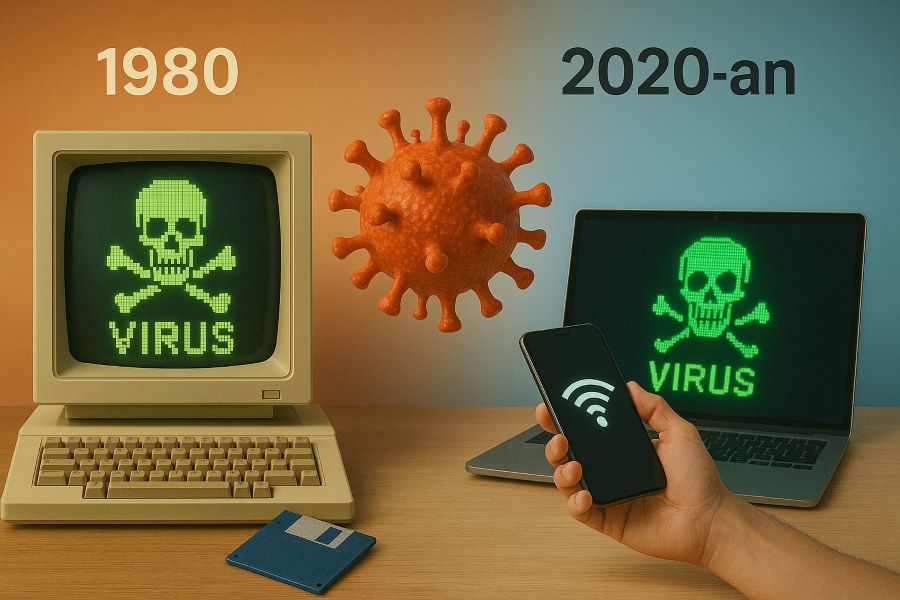Have you ever imagined that the first virus spread via diskette?? Explore the complete history of computer viruses from Elk Cloner (1981) until WannaCry (2017). Understand the evolution of malware from floppy disks to world-shaking ransomware. Read the timeline here!
The digital world we know today is not free from threats that continue to evolve: computer viruses. Its journey began with a fad program that spread via floppy disks, until it turns into a sophisticated cyber weapon capable of paralyzing the global network in a matter of minutes. Let's explorethe history of a computer virus and understand how this threat evolved from the floppy disk era to the wireless era, changing the digital security landscape forever.
Recently the most horrendous virus is Wannacry Ransomware. This ransomware attack spread through computer networks running Microsoft Windows starting in 12 Mei 2017. Wannacry ransomware takes users' files hostage, and demanded a ransom payment inBitcoin cryptocurrency.
What is the history of computer viruses and their development in this world, please read until the end.
List of contents
History of Computer Viruses from Year to Year
🕹️ Pioneer Era: Viruses in the Age of the Floppy Disk (1981-1989)
This era marked the birth of viruses as “proof of concept”, where the main distribution still relies on physical media such as diskettes.
1981
First 'in the wild' virus discovered. This virus, called Elk Cloner, spread via floppy disks on Apple II computers.
1986
A pair of brothers from Pakistan, Basit and Amjad, created the first boot sector virus, named Brain. Brain is often referred to as the world's first computer virus.
1987
File infector viruses like Leigh are starting to appear, mostly attacks COM files likeCOMMAND.COM. In the same year the first virus attacking EXE files appeared, Suriv 01 And 02 as well as Jerusalem. IBM mainframes experienced an IBM Christmas Worm worm attack with a replication rate of half a million copies per hour.
1988
The first virus to attack Macintosh computers, MacMag and Scores, appear. In the same year CERT was founded (Computer Emergency Response Team) by DARPA with the initial aim of overcoming the Morris Worm attack created by Robert Morris.
1989
AIDS Trojan appears as a trojan that disguises itself as an AIDS information program. When executed this trojan will encrypt the hard drive and demand payment for the decryption key.This was the forerunner of modern ransomware.
💻Digital Age: Tool Kits, Macro, and New Threats (1990-1999)
With the rise of the internet and commercial software, viruses began to find new mediums and became easier to manufacture.
1990
Virus Exchange Factory (VX) BBS, which is an online discussion forum for virus creators, was founded in Bulgaria. Mark Ludwig wrote the book "The Little Black Book of Computer Viruses" which contains methods for creating various types of computer viruses.
1991
The first polymorphic virus, Tequila, appeared in Switzerland. This virus can change itself to avoid detection.
1992
The presence of the Michaelangelo virus is a threat to the entire world. The emergence of several tools that can be used to create viruses such as the Dark Avenger Mutation Engine (DAME) which can turn any virus into a polymorphic virus, and Lab Creation Virus (VCL) which is the first kit that can be used to create viruses.

1995
Hackers under the name 'Internet Liberation Front' carried out many attacks on Thanksgiving Day. Some of the agencies that were victims of this attack were Griffith Air Force Base, Korean Atomic Research Institute, NASA, GE, IBM. The first macro virus to attack the Microsoft Word application, Concept, developed.
1996
The emergence of the Boza virus which is specifically designed to attack Windows files 95. The Laroux virus was the first virus to attack Microsoft Excel. The Staog virus is the first Linux virus.
1998
The appearance of the first Java virus, Strange Brew. Back Orifice is the first trojan that can be used as a tool to take control of a remote computer via the Internet.
1999
The emergence of the Melissa virus which is a combination of a macro virus and a worm that uses the address book in Microsoft Outlook to spread via email. Bubbleboy is the first worm that can be activated just by opening an email via the Microsoft Outlook application without requiring attachments.Social engineering is becoming a new weapon.
🌐 New Millennium: The Explosion of Global Attacks and Social Engineering (2000-2003)
The increasingly open Internet is fueling an explosion of global attacks of unprecedented speed and impact.
2000
Distributed Denial of Service Attack (DDoS) first doing damage to big sites like Yahoo!, Amazon.com, and others. Virus ILOVEYOU was the worm with the highest spreading speed at that time which caused damage to many email systems around the world. Pertama kali worm ini ditemukan di Filipina.
ILoveYou ditulis menggunakan bahasa pemrograman tingkat tinggi Visual Basic Script, dan dapat menyebar baik melalui email maupun perpindahan file. Virus ini memikat para penerima email untuk membuka attachment yang disertakan dalam email.

2001
Gnuman (Mandrake) was the first worm to attack peer to peer communication networks. The emergence of viruses designed to attack both Windows and Linux operating systems, like Winux or Lindose.
2002
The LFM-926 virus was the first virus to attack Shockwave Flash application files. Donut was the first worm to attack .NET services.
2003
VirusBlaster infect more than 250.000 Windows computer in less than 24 jam. VirusSlammer It is believed to be the fastest spreading computer virus ever released into cyberspace, spreading at a rate of about one million computers per minute.
💸 Era Modern: Ransomware and Cyber Weapons (2017)
This era was characterized by financial motives and the use of sophisticated exploitation, often involving state actors.
2017
Ransomware cyber attackWannacry around the world starting in 12 Mei 2017. This attack, which uses the NSA's EternalBlue exploit, holding user files hostage and demanding ransom payments in Bitcoin.This incident shows how government security gaps can be leaked and used to launch global attacks.

Conclusion
From physical boot sector media to attacks via the internet network, The history of computer viruses is a reflection of the development of technology itself. The challenges of the future are even more frightening in their presenceArtificial Intelligence (AI). This technology has the potential to be misused to create malware that can learn, evolve independently, and launch attacks that are highly personal and difficult to detect.
Face this reality, Our long journey against computer viruses is entering a whole new chapter, where proactive defense and human intelligence remain reliable weapons. Apa sebenarnya virus komputer itu dan bagaimana cara kerjanya? Simak artikel Get to know computer viruses and how they work.
Reference
- [1] Fred Cohen. Computer Viruses – Theory and Experiments. 1984.
- [2] Xin Li. Computer Viruses: The Threat Today and The Expected Future. Linkoping Institue of Technology. 2003.
- [3] Marko Helenius. A System to Support the Analysis of Antivirus Products’ VirusDetection Capabilities. 2002.
- [4] Mark Ludwig. The Little Black Book of Computer Viruses – Electronic Edition. American Eagle Publications, Inc. 1990.
- [5] Mark Ludwig. The Giant Black Book of Computer Viruses. American Eagle Publications, Inc. 1994.
- http://www.cert.org/advisories/CA-2000-04.html







